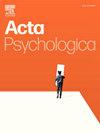Prefrontal cortex activation and working memory performance in individuals with non-clinical depression: Insights from fNIRS
IF 2.7
4区 心理学
Q2 PSYCHOLOGY, EXPERIMENTAL
引用次数: 0
Abstract
Previous research has extensively explored cognitive and neural deficits in clinically diagnosed depression, but the early stages of depression, where symptoms do not meet clinical thresholds, are less explored. This study investigated neurocognitive markers in individuals with non-clinical depression. The study assessed working memory (WM) performance and hemodynamic responses of prefrontal cortex (PFC) in 30 individuals with non-clinical depression and 41 healthy controls using two-back tasks with four stimulus types: numbers, letters, shapes, and emotional facial expressions. Hemodynamic responses were measured via oxyhemoglobin (HbO) using functional near-infrared spectroscopy. Results showed that individuals with non-clinical depression have significantly lower WM performance compare to healthy controls, particularly for shape- and emotional facial expression-based tasks. No differences were observed for the number- and letter- based tasks. Additionally, individual with non-clinical depression exhibited elevated HbO levels, indicating increased PFC activation. Specifically, significant HbO differences observed in the bilateral ventrolateral PFC during shape-based tasks, and in the left medial, bilateral orbital, and bilateral ventrolateral PFCs during emotional facial expression-based tasks. In conclusion, individuals with non-clinical depression may experience WM deficits and PFC dysregulation, even without a clinical diagnosis. This study highlights the role of stimulus type in understanding WM performance and PFC activation in depression.
非临床抑郁症患者的前额叶皮层激活和工作记忆能力:来自 fNIRS 的启示。
以往的研究广泛探讨了临床诊断抑郁症患者的认知和神经缺陷,但对症状未达到临床阈值的抑郁症早期阶段的研究较少。本研究调查了非临床抑郁症患者的神经认知指标。研究使用四种刺激类型(数字、字母、形状和情绪面部表情)的双向任务,评估了 30 名非临床抑郁症患者和 41 名健康对照者的工作记忆(WM)表现和前额叶皮层(PFC)的血液动力学反应。使用功能性近红外光谱通过氧合血红蛋白(HbO)测量血液动力学反应。结果显示,与健康对照组相比,非临床抑郁症患者的WM表现明显较低,尤其是在基于形状和情绪面部表情的任务中。在基于数字和字母的任务中则没有观察到差异。此外,非临床抑郁症患者的 HbO 水平升高,表明前脑功能区激活增加。具体来说,在进行基于形状的任务时,在双侧腹外侧 PFC 观察到明显的 HbO 差异;在进行基于情绪面部表情的任务时,在左内侧、双侧眼眶和双侧腹外侧 PFC 观察到明显的 HbO 差异。总之,即使没有临床诊断,非临床抑郁症患者也可能出现 WM 缺陷和 PFC 调节障碍。本研究强调了刺激类型在理解抑郁症患者WM表现和PFC激活中的作用。
本文章由计算机程序翻译,如有差异,请以英文原文为准。
求助全文
约1分钟内获得全文
求助全文
来源期刊

Acta Psychologica
PSYCHOLOGY, EXPERIMENTAL-
CiteScore
3.00
自引率
5.60%
发文量
274
审稿时长
36 weeks
期刊介绍:
Acta Psychologica publishes original articles and extended reviews on selected books in any area of experimental psychology. The focus of the Journal is on empirical studies and evaluative review articles that increase the theoretical understanding of human capabilities.
 求助内容:
求助内容: 应助结果提醒方式:
应助结果提醒方式:


